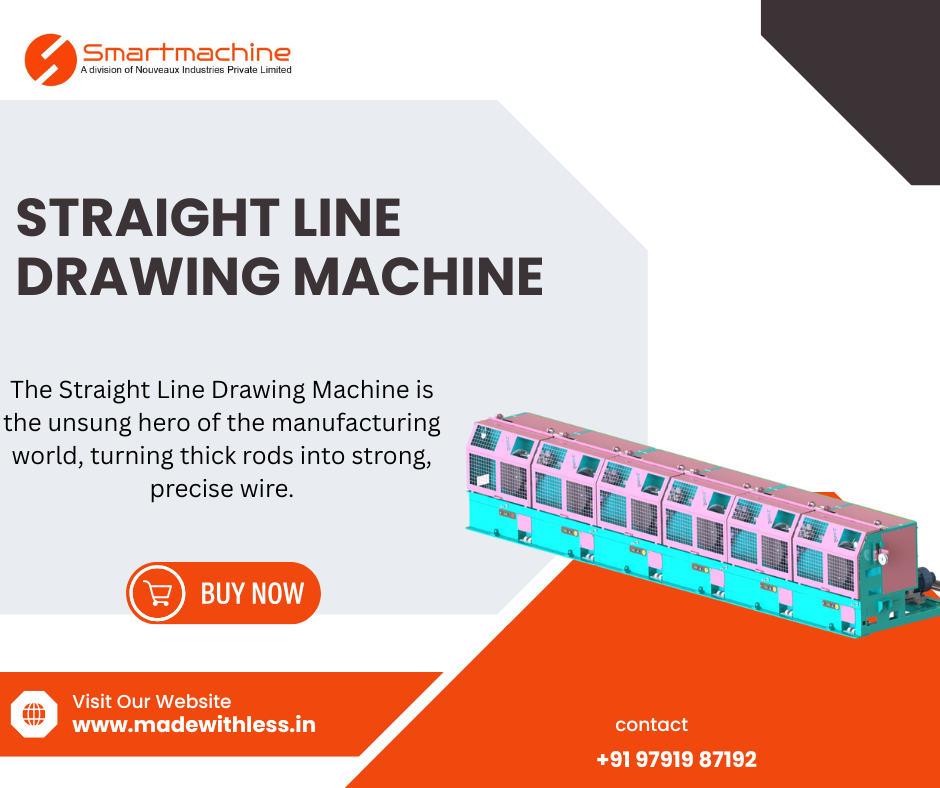In the world of metalworking and wire production, precision, efficiency, and consistency are paramount. At the heart of this process lies a crucial piece of equipment: the Straight Line Drawing Machine. This machine is the workhorse responsible for transforming thick wire rods into thinner, finer, and stronger wires of precise diameters.
But what exactly is a straight line drawing machine, and why is it so indispensable across various industries? This guide delves into its key features, significant benefits, and wide-ranging applications.

What is a Straight Line Drawing Machine?
A Straight Line Drawing Machine is an industrial device used to reduce the cross-sectional diameter of a wire by pulling it through a series of progressively smaller dies. Unlike other types of drawing machines, the wire travels in a single, straight line through multiple dies in a continuous process. This “straight-line” configuration is particularly effective for intermediate to heavy drawing applications, producing coils of wire with exceptional dimensional accuracy and superior surface finish.
Key Features of a Modern Straight Line Drawing Machine
Modern straight line drawing machines are engineering marvels designed for high performance and reliability. Key features include:
- Robust Construction: Built with heavy-duty steel frames and components to withstand high tensile forces and ensure long-term stability, minimizing vibrations during operation.
- Multi-Die Configuration: The machine houses a sequence of tungsten carbide or diamond dies, each one slightly smaller than the previous, to achieve the desired final diameter in a single, continuous pass.
- Powerful Drive System: Equipped with energy-efficient AC or DC motors that provide the consistent, high torque needed to pull the wire through the dies without breaking.
- Integrated Cooling Systems: Essential for dissipating the immense heat generated by friction during the drawing process. Efficient cooling (through water or air) extends die life and prevents wire annealing, which can weaken the material.
- Automatic Pay-off and Take-up Systems: These systems facilitate the seamless feeding of the initial rod (pay-off) and the coiling of the finished wire (take-up reel), enabling continuous operation and reducing manual labor.
- Pre-Treatment Capabilities: Many machines include an integrated entry point for lubricants or pre-coating systems to reduce friction and improve the surface quality of the final wire.
Major Benefits of Using a Straight Line Drawing Machine
Investing in a straight line drawing machine offers a multitude of advantages for wire manufacturers:
- High Production Efficiency: The continuous, straight-line process allows for high-speed operation and large batch production, significantly boosting output.
- Superior Surface Finish: The process produces a smooth, clean, and consistent wire surface, which is often ready for further processing or coating without extensive cleaning.
- Excellent Dimensional Accuracy: The precision-engineered dies and stable pulling mechanism ensure tight tolerances and uniform diameter throughout the entire length of the wire.
- Enhanced Mechanical Properties: The cold-working drawing process increases the tensile strength and hardness of the wire through a phenomenon called “strain hardening.”
- Reduced Operational Costs: High automation lowers labor requirements, while durable components and efficient designs minimize downtime and maintenance costs.
- Material Versatility: These machines can process a wide range of ferrous and non-ferrous metals, including steel, copper, aluminum, and their alloys.
Diverse Industrial Applications
The wire produced by straight line drawing machines is a fundamental component in countless products and industries. Key applications include:
- Wire Mesh and Fencing: The primary use, producing the high-tensile wires needed for welded mesh, chain-link fencing, gabions, and security fencing.
- Fastener Manufacturing: Used to create the wire that is then forged or machined into bolts, nuts, screws, and nails.
- Automotive Industry: Produces tire bead wire, spring wire, and other critical components that require high strength and reliability.
- Construction and Pre-Stressed Concrete: Manufactures the high-strength steel wire and strands used in pre-stressed concrete elements like bridges, beams, and piles.
- Electrical and Cable Industry: Draws copper and aluminum rods down to the precise diameters required for electrical conductors, winding wires, and communication cables.
- General Engineering and Appliances: Supplies wire for springs, wire forms, shopping carts, and various components in white goods and industrial machinery.
Conclusion
The Straight Line Drawing Machine is far more than just a piece of factory equipment; it is a cornerstone of modern manufacturing. Its ability to efficiently and precisely transform raw metal into high-quality, high-strength wire makes it an invaluable asset across a vast spectrum of industries. By understanding its robust features, operational benefits, and critical applications, manufacturers can appreciate its role in producing the essential materials that build our world.
Looking for a reliable drawing solution for your wire production needs? Understanding the capabilities of a straight line drawing machine is the first step toward optimizing your manufacturing process for quality and efficiency.
